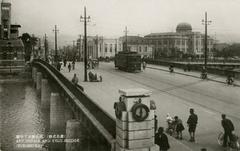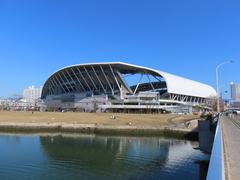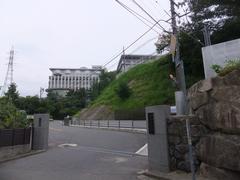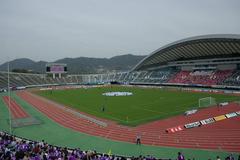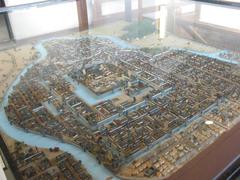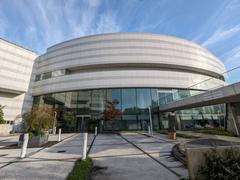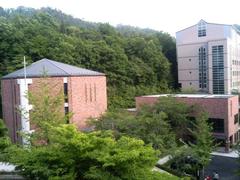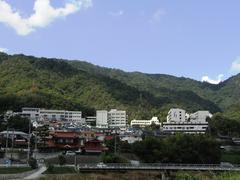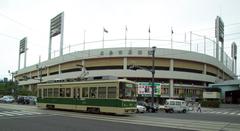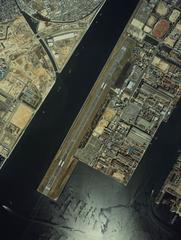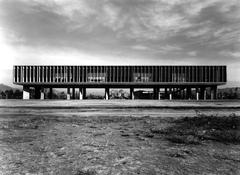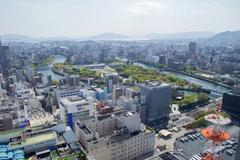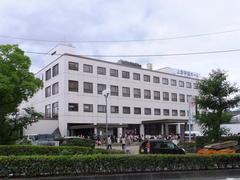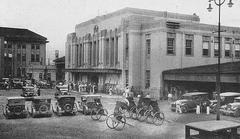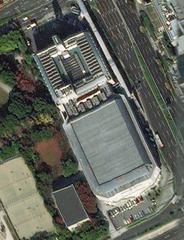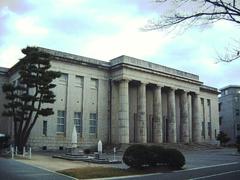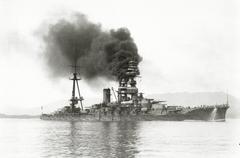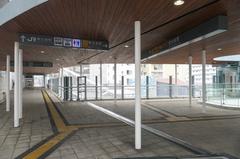
Kōiki-Kōen-Mae Station Hiroshima: Visiting Hours, Tickets, and Nearby Attractions Guide
Date: 04/07/2025
Introduction: The Significance of Kōiki-Kōen-Mae Station in Hiroshima
Kōiki-Kōen-Mae Station, located in the northwestern part of Hiroshima City, is a pivotal gateway for travelers seeking to experience both Hiroshima’s rich history and its modern urban vibrancy. Established in 1994 with the inauguration of the Astram Line—timed with Hiroshima’s hosting of the 1994 Asian Games—the station was designed to efficiently accommodate large crowds, especially those attending events at the neighboring Edion Stadium Hiroshima (formerly Hiroshima Big Arch). Its opening marked a major shift in connecting the city’s expanding urban landscape, reflecting Hiroshima’s commitment to sustainable mobility and accessibility.
Today, the station not only serves as a vital transportation hub with barrier-free access, multilingual signage, and IC card ticketing, but also as a starting point for exploring Hiroshima’s most iconic sites. These include the Peace Memorial Park, Atomic Bomb Dome, Hiroshima City Transportation Museum, Saijō Sake Town, and Miyajima Island. The station’s proximity to Edion Stadium and other event venues means visitors can enjoy a diverse calendar of sports, music, and cultural festivals throughout the year.
This guide provides practical information on visiting hours, ticketing options, facilities, and connections, as well as tips on nearby attractions and cultural highlights. Whether you are attending a major event, tracing Hiroshima’s historical narrative, or sampling local cuisine, this article will help you make the most of your visit. For real-time updates and further details, consult resources like the Japan Travel Access Guide and the Wikipedia Astram Line page.
Contents Overview
- Early Urban Development of Hiroshima and the Kōiki-Kōen-Mae Area
- The 1994 Asian Games and the Birth of the Astram Line
- Visitor Information: Hours, Tickets, Accessibility
- Nearby Attractions and Travel Tips
- Urban Planning and Integration
- Socioeconomic Impact and Development
- Kōiki-Kōen-Mae in Hiroshima’s Urban Identity
- Astram Line and Station Overview
- Facilities and Services
- Event Access and Crowd Management
- Historical Sites and Attractions
- Visitor Tips and FAQs
- Integration with Hiroshima’s Transit Network
- Edion Stadium Hiroshima Access Guide
- Attractions, Cultural Insights, and Events
- Summary and Official Sources
Early Urban Development of Hiroshima and the Kōiki-Kōen-Mae Area
Hiroshima’s evolution from a feudal castle town to a dynamic metropolis has been shaped by history, reconstruction, and modern planning. The area surrounding Kōiki-Kōen-Mae Station remained mainly rural until the post-war era. After the devastation of World War II, Hiroshima’s population and infrastructure rebounded rapidly, paving the way for urban expansion and new transit solutions (Japan Guide).
The 1994 Asian Games and the Birth of the Astram Line
Hosting the 1994 Asian Games was a catalyst for Hiroshima’s infrastructure development. The construction of Hiroshima Big Arch (now Edion Stadium) and the Astram Line transformed the region. The rapid transit Astram Line, opened in August 1994, connects central Hiroshima (Hondori) to the northwest, with Kōiki-Kōen-Mae Station serving as its northern terminus and stadium gateway (Japan Travel Access Guide). The station was uniquely designed for crowd management, with spacious platforms and direct park access.
Visitor Information: Hours, Tickets, and Accessibility
- Station Operating Hours: First trains depart around 6:02 AM; last arrivals are by 11:51 PM, with facilities closing by 12:37 AM (MetroEasy).
- Ticketing: Tickets are available at vending machines (accepting cash and major IC cards like Suica, ICOCA, PASPY). Fare depends on distance; as of January 2025, base fares increased by up to ¥30 after more than three decades (Wikipedia - Astram Line).
- Accessibility: The station is fully barrier-free, with elevators, escalators, tactile paving, and multilingual signage to assist all travelers.
- Event Tickets: For Edion Stadium events (sports, concerts), check official schedules and purchase tickets in advance online, at convenience stores, or at the stadium box office.
Nearby Attractions and Travel Tips
- Edion Stadium Hiroshima: Adjacent to the station, this 50,000-seat venue hosts J-League football (Sanfrecce Hiroshima), athletics, and major concerts (Mapcarta).
- Hiroshima City Transportation Museum: Family-friendly museum with historic vehicles and interactive exhibits, including the “A-Bomb Tram” (PlanetWare).
- Peace Memorial Park & Atomic Bomb Dome: Easily accessed via connecting transit lines, these sites are central to Hiroshima’s history.
- Saijō Sake Town: A renowned sake brewing district with historic breweries, tours, and tastings (The Poor Traveler).
- Miyajima Island: Home to the floating torii of Itsukushima Shrine, accessible by ferry from Hiroshima Port (The Invisible Tourist).
- Okunoshima (Rabbit Island): Famous for its free-roaming rabbits, accessible by ferry from Tadanoumi Port (The Poor Traveler).
Travel Tips: Avoid peak commuting times on event days; use IC cards for convenience; take advantage of bicycle-sharing and pedestrian-friendly paths (Metro Line Map).
Urban Planning and Integration
The Astram Line’s construction spurred rapid local development, with new housing, schools, and retail transforming the area into a vibrant community. The station’s integration with trams and JR lines furthers Hiroshima’s commitment to sustainable, connected urban living (Mapa Metro Hiroshima).
Socioeconomic Impact
Kōiki-Kōen-Mae Station is essential for local events, sports, and tourism, boosting the economy and fostering community pride. Ongoing investments in transit and urban design reflect Hiroshima’s focus on sustainability and quality of life (Japan Travel Access Guide).
Kōiki-Kōen-Mae Station’s Role in Hiroshima’s Identity
The station is a symbol of Hiroshima’s resilience and forward-thinking spirit, having transformed a rural periphery into a thriving suburban hub and global event destination.
Overview of the Astram Line and Kōiki-Kōen-Mae Station
The Astram Line
The Astram Line, or Hiroshima New Transit Line 1, is a key rapid transit artery operated by Hiroshima Rapid Transit (HRT). Spanning 18.4 km and 21 stations, it efficiently links downtown Hiroshima (Hondori Station) with the city’s northwest, culminating at Kōiki-Kōen-Mae (Wikipedia - Astram Line).
Station Location and Importance
Located at 4-4-8 Ozuka-nishi, Asaminami-ku, Kōiki-Kōen-Mae Station is the gateway to Edion Stadium and Hiroshima’s sporting and cultural events (Wikipedia - Kōiki-Kōen-Mae Station).
Visiting Hours and Ticket Information
- Opening: First train leaves at 6:02 AM
- Closing: Last train by 11:51 PM; station closes at 12:37 AM (MetroEasy)
- Fares: Example—Hondori to Kōiki-Kōen-Mae is approx. ¥470.
- IC Cards: ICOCA, Suica, PASPY, and more accepted.
- Tourist Passes: The Visit Hiroshima Tourist Pass provides unlimited travel on the Astram Line, Hiroden streetcars, and buses.
Facilities and Services
- Layout: Spacious island platforms; efficient boarding
- Accessibility: Elevators, escalators, tactile paving, accessible restrooms
- Signage: Multilingual (Japanese/English)
- Amenities: Restrooms, waiting areas, convenience stores, public Wi-Fi (World of Metro)
- Safety: CCTV, AEDs, emergency systems
Event Access and Crowd Management
During major events, Kōiki-Kōen-Mae Station increases train frequency and deploys extra staff, with real-time updates on digital boards and temporary wayfinding (Japan Travel).
Nearby Historical Sites and Attractions
Notable sites easily reached from Kōiki-Kōen-Mae Station include:
- Peace Memorial Park & Museum: UNESCO site; open 8:30 AM–6:00 PM; museum entrance ¥200 (Hiroshima Peace Memorial Park)
- Hiroshima Castle: Reconstructed samurai-era landmark
- Shukkeien Garden: Traditional landscaped garden
Tips for Visitors
- Arrive early for events to avoid congestion
- Use IC cards for seamless travel
- Store luggage in coin lockers
- Ask staff for accessibility assistance if needed
- Confirm schedules and fares on official websites or station displays
Integration with Hiroshima’s Transit Network
The Astram Line interconnects with Hiroshima’s streetcars, buses, and JR lines. Key transfers at Ōmachi and Shin-Hakushima enhance access to regional destinations (MetroEasy).
How to Reach Edion Stadium Hiroshima: Astram Line Transport Guide
Astram Line Connectivity
- Length: 18.4 km, 21 stations
- Travel Time: ~40 minutes from Hondori to Kōiki-Kōen-Mae
- Frequency: Every 6–10 minutes at peak
- Transfer: From Hiroshima Station, take Hiroden streetcar to Hondori, then Astram Line to Kōiki-Kōen-Mae (Japan Travel; JoyinHiroshima)
Fare and Ticketing
- Single Fare: ~¥470 from Hondori to Kōiki-Kōen-Mae
- IC Cards: ICOCA, Suica, PASPY accepted
- Tourist Pass: Visit Hiroshima Tourist Pass
Edion Stadium Visiting Information
- Events: Stadium opens ~2 hours before events; tickets online, at convenience stores, or at the stadium
- Accessibility: Full wheelchair access
- Guided Tours: Occasionally available; check event schedules
Nearby Sites
- Peace Memorial Park
- Hiroshima Castle
- Shukkeien Garden
Practical Visitor Tips
- Arrive early on event days; prepare for weather (walk from station is mostly uncovered)
- English signage is available, but translation apps may be helpful
- Food stalls and shops are plentiful on event days
Attractions, Cultural Insights, and Events
Notable Nearby Attractions
- Edion Stadium Hiroshima: Home to Sanfrecce Hiroshima and venue for major concerts (Mapcarta)
- Hiroshima City Transportation Museum: Interactive transit exhibits (PlanetWare)
- Miyajima (Itsukushima Shrine): Famous for the floating torii gate (The Invisible Tourist)
- Saijō Sake Town: Sake brewery tours and tastings (The Poor Traveler)
- Okunoshima (Rabbit Island): Unique wildlife experience (The Poor Traveler)
Cultural Insights
- Peace Culture: The annual Peace Memorial Ceremony on August 6 reflects Hiroshima’s dedication to peace (Japan Travel)
- Local Cuisine: Okonomiyaki, oysters, and sake are local specialties (Discover Japan Blog)
- Festivals: Hiroshima Flower Festival in May, Saijō Sake Festival in October, and Oyster Festival in February are highlights (Discover Japan Blog)
Major Events
- Peace Memorial Ceremony: August 6 (Japan Travel)
- Hiroshima Flower Festival: Early May (Discover Japan Blog)
- Saijō Sake Festival: October (Discover Japan Blog)
- Oyster Festival: February (Discover Japan Blog)
- International Film Festival, Fireworks, and Matsuri: Throughout the year (Adventure Backpack)
Visual Aids and Maps
Map showing the Astram Line route and key connecting stations.
Main entrance to Kōiki-Kōen-Mae Station, accessible and well-signposted.
Edion Stadium Hiroshima exterior view.
Summary Table: Key Facts
| Feature | Details |
|---|---|
| Line | Astram Line (Hiroshima Rapid Transit) |
| Terminus | Kōiki-Kōen-Mae Station (northern end, near Edion Stadium) |
| City Center Access | Hondori Station (downtown, shopping, entertainment) |
| Travel Time | ~40 minutes from Hondori to Kōiki-Kōen-Mae |
| Fare (one-way) | ~¥470 (Hondori to Kōiki-Kōen-Mae) |
| IC Card Accepted | Yes (ICOCA, Suica, PASPY, etc.) |
| Tourist Pass Available | Yes (Visit Hiroshima Tourist Pass) |
| Accessibility | Elevators, escalators, accessible restrooms |
| Nearby Landmark | Edion Stadium Hiroshima (Sanfrecce Hiroshima home stadium) |
| Station Facilities | Lockers, restrooms, bilingual signage |
| Last-Mile Options | Walking, taxis, local buses |
FAQs
Q: What are Kōiki-Kōen-Mae Station’s operating hours?
A: First train at 6:02 AM; last at 11:51 PM. Facilities close by 12:37 AM.
Q: How to buy tickets?
A: Via vending machines (cash, IC cards) or Tourist Pass.
Q: Is the station accessible?
A: Yes, with elevators, ramps, tactile paving, and staff assistance.
Q: Which attractions can I reach?
A: Edion Stadium, Peace Memorial Park, Hiroshima Castle, Saijō Sake Town, Miyajima, and more.
Q: Are there extra services during events?
A: Yes, with more trains, staff, and crowd control.
Planning Your Visit and Staying Updated
To maximize your Hiroshima experience:
- Download the Audiala app for real-time updates and travel tips
- Follow official websites and resources for the latest event, schedule, and fare information
- Explore related articles for detailed guides and itineraries
For more, see the Japan Travel Access Guide and the Astram Line Wikipedia page.
Sources
- Japan Guide
- Japan Travel Access Guide
- Wikipedia - Astram Line
- Wikipedia - Kōiki-Kōen-Mae Station
- MetroEasy Astram Line Hiroshima
- World of Metro: Hiroshima Rapid Transit Line Astram Line Tourist Guide
- Mapcarta - Hiroshima Big Arch
- PlanetWare - Hiroshima City Transportation Museum
- The Poor Traveler - Things to Do in Hiroshima Attractions
- The Invisible Tourist - 2 Weeks in Japan Itinerary
- Discover Japan Blog - Hiroshima’s Festivals
- Adventure Backpack - Hiroshima Events

